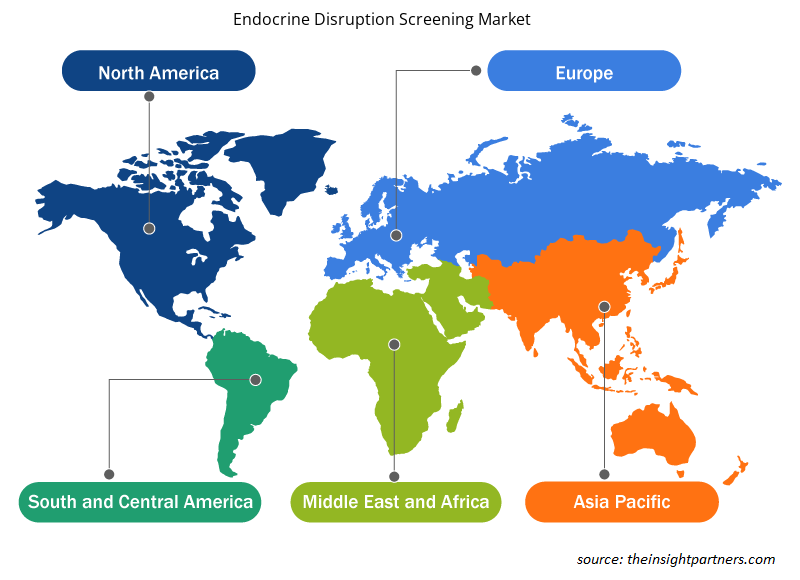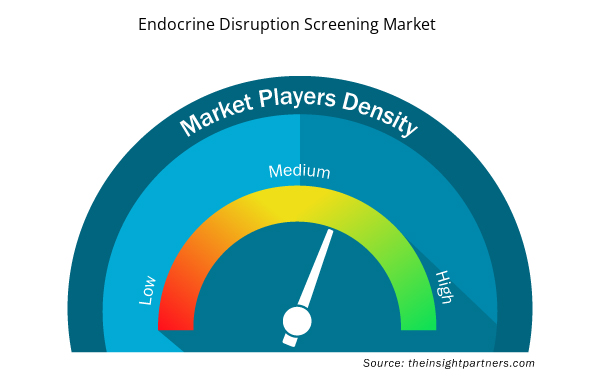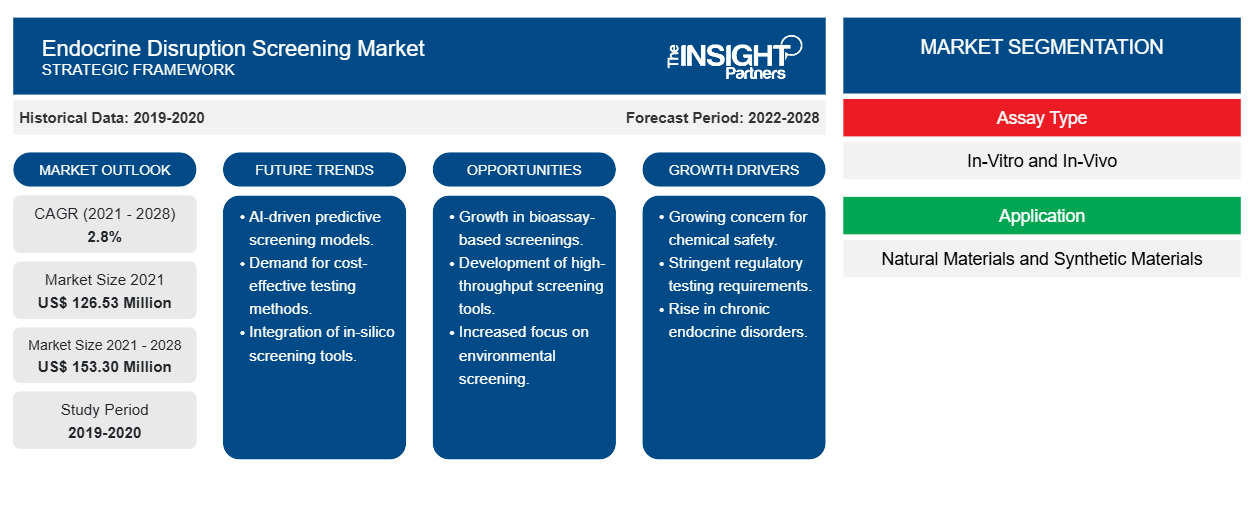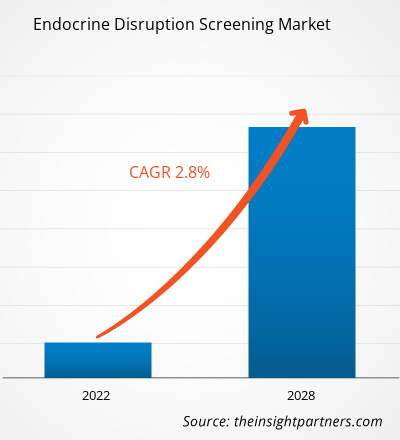Se proyecta que el mercado de detección de alteraciones endocrinas alcance los 153,30 millones de dólares en 2028, desde los 126,53 millones de dólares en 2021; se espera que crezca a una CAGR del 2,8% entre 2021 y 2028.
Muchos productos químicos, tanto naturales como artificiales, tienen el potencial de imitar o interferir con el sistema endocrino, que regula las hormonas del cuerpo. Estos productos químicos, conocidos como disruptores endocrinos, se han relacionado con trastornos del desarrollo, reproductivos, cerebrales, inmunológicos y de otro tipo. Los disruptores endocrinos pueden estar presentes en una variedad de artículos comunes, como algunas botellas y recipientes de plástico, revestimientos metálicos para latas de alimentos, detergentes, retardantes de llama, alimentos, juguetes, cosméticos y pesticidas. Los pesticidas, los productos químicos y las toxinas ambientales se examinan utilizando un método de dos niveles para determinar su posible efecto sobre los sistemas de estrógeno, andrógeno y hormona tiroidea mediante el examen de disruptores endocrinos.
El crecimiento del mercado de detección de alteraciones endocrinas se atribuye a la creciente investigación en el sector de la biotecnología y a la creciente prevalencia de trastornos endocrinos. Sin embargo, el alto costo de la tecnología de detección obstaculiza el crecimiento del mercado.
Personalice este informe según sus necesidades
Obtendrá personalización en cualquier informe, sin cargo, incluidas partes de este informe o análisis a nivel de país, paquete de datos de Excel, así como también grandes ofertas y descuentos para empresas emergentes y universidades.
- Obtenga las principales tendencias clave del mercado de este informe.Esta muestra GRATUITA incluirá análisis de datos, desde tendencias del mercado hasta estimaciones y pronósticos.
Perspectivas de mercado
La creciente prevalencia de trastornos endocrinos impulsa el mercado de detección de alteraciones endocrinas
La acromegalia (sobreproducción de la hormona del crecimiento), la obesidad, el síndrome metabólico, la alteración de la glucosa en ayunas, la alteración de la tolerancia a la glucosa, la osteoporosis, la osteopenia, la hipovitaminosis D leve a moderada, la disfunción eréctil, la dislipidemia y la tiroiditis se encuentran entre los trastornos endocrinos que tienen una prevalencia colectiva de al menos el 5% entre los adultos en los EE. UU. De estas afecciones, los hombres tienen la mayor incidencia de disfunción eréctil, mientras que las mujeres tienen la mayor incidencia de osteopenia/osteoporosis. La diabetes mellitus en niños y el adenoma hipofisario son las afecciones menos comunes, que afectan a menos del 1% de la población estadounidense. El carcinoma adrenocortical, el feocromocitoma y los adenomas hipofisarios son las afecciones con la incidencia más baja. El hiperparatiroidismo y los trastornos tiroideos son más comunes en las mujeres. La diabetes mellitus es más prevalente entre las minorías étnicas. Las enfermedades endocrinas y metabólicas se encuentran entre las dolencias humanas modernas más comunes, particularmente en los EE. UU. y otros países que implementan amplios programas de nutrición y detección para individuos de alto riesgo. Los trastornos endocrinos como el hiperparatiroidismo, el hipogonadismo primario y secundario, la deficiencia de GH y el hipotiroidismo pueden dar lugar a otros trastornos, como la enfermedad ósea metabólica y la diabetes mellitus. Por ello, la creciente prevalencia e incidencia de dichas afecciones impulsa la demanda de productos de detección de alteraciones endocrinas.
Información basada en el tipo de ensayo
El mercado de detección de alteraciones endocrinas, por tipo de ensayo, se divide en in vitro e in vivo. El segmento in vitro lideró el mercado en 2021, contribuyendo con una participación de mercado del 64,45 %, y se espera que mantenga su dominio durante el período de pronóstico para representar una participación de mercado del 65,73 % de los ingresos generales generados en 2028.
Perspectivas basadas en aplicaciones
Por aplicación, el mercado de detección de alteraciones endocrinas se divide en materiales naturales y materiales sintéticos. En 2021, el segmento de materiales naturales tuvo una mayor participación en el mercado. Además, se espera que el mercado del mismo segmento crezca a una CAGR más rápida del 3,1 % durante 2021-2028.
Fuente de información basada en residuos
El mercado de detección de alteraciones endocrinas, por fuente de desechos, se segmenta en incineración y vertederos, escorrentías agrícolas, efluentes industriales y municipales, efluentes de plantas de pulpa, productos de consumo y otros. En 2021, el segmento de incineración y vertederos tuvo la mayor participación del mercado. Además, se espera que el mercado para el mismo segmento crezca a la CAGR más rápida del 3,5% durante 2021-2028.
Perspectivas basadas en métodos
El mercado de detección de alteraciones endocrinas, por método, se segmenta en transactivación del receptor de estrógeno (ER), transactivación del receptor de andrógeno (AR), modulación del receptor de andrógeno (AR), unión del receptor de estrógeno alfa (ER), unión del receptor de estrógeno beta (ER), unión del receptor de andrógeno (AR), esteroidogénesis, ensayo de aromatasa y otros. En 2021, el segmento de transactivación del receptor de estrógeno (ER) tuvo la mayor participación del mercado. Además, se espera que el mercado del mismo segmento crezca a la CAGR más rápida del 3,7% entre 2021 y 2028.
Información basada en el usuario final
El mercado de detección de alteraciones endocrinas, en función del uso final, está segmentado en empresas farmacéuticas y biofarmacéuticas, empresas de cosméticos y productos para el hogar, industria alimentaria e industria química. En 2021, el segmento de empresas farmacéuticas y biofarmacéuticas tuvo la mayor participación del mercado. Además, se espera que el mercado del mismo segmento crezca a la tasa compuesta anual más rápida del 3,3 % durante 2021-2028.
Los lanzamientos y aprobaciones de productos son estrategias que las empresas suelen adoptar para ampliar su presencia global y sus carteras de productos. Además, los actores del mercado de detección de trastornos endocrinos se centran en la estrategia de asociación para ampliar su clientela, lo que, a su vez, les permite mantener su marca en todo el mundo.
Perspectivas regionales del mercado de detección de alteraciones endocrinas
Los analistas de Insight Partners explicaron en detalle las tendencias y los factores regionales que influyen en el mercado de detección de alteraciones endocrinas durante el período de pronóstico. Esta sección también analiza los segmentos y la geografía del mercado de detección de alteraciones endocrinas en América del Norte, Europa, Asia Pacífico, Oriente Medio y África, y América del Sur y Central.

- Obtenga datos regionales específicos para el mercado de detección de alteraciones endocrinas
Alcance del informe de mercado sobre detección de alteraciones endocrinas
| Atributo del informe | Detalles |
|---|---|
| Tamaño del mercado en 2021 | US$ 126,53 millones |
| Tamaño del mercado en 2028 | US$ 153,30 millones |
| CAGR global (2021-2028) | 2,8% |
| Datos históricos | 2019-2020 |
| Período de pronóstico | 2022-2028 |
| Segmentos cubiertos | Por tipo de ensayo
|
| Regiones y países cubiertos | América del norte
|
| Líderes del mercado y perfiles de empresas clave |
|
Densidad de actores del mercado: comprensión de su impacto en la dinámica empresarial
El mercado de detección de alteraciones endocrinas está creciendo rápidamente, impulsado por la creciente demanda de los usuarios finales debido a factores como la evolución de las preferencias de los consumidores, los avances tecnológicos y una mayor conciencia de los beneficios del producto. A medida que aumenta la demanda, las empresas amplían sus ofertas, innovan para satisfacer las necesidades de los consumidores y aprovechan las tendencias emergentes, lo que impulsa aún más el crecimiento del mercado.
La densidad de actores del mercado se refiere a la distribución de las empresas o firmas que operan dentro de un mercado o industria en particular. Indica cuántos competidores (actores del mercado) están presentes en un espacio de mercado determinado en relación con su tamaño o valor total de mercado.
Las principales empresas que operan en el mercado de detección de alteraciones endocrinas son:
- BIOARREGLAS CREATIVAS
- XENOMETRIX AG
- Río Charles
- EUROFINS CIENTÍFICO
- Herreros
Descargo de responsabilidad : Las empresas enumeradas anteriormente no están clasificadas en ningún orden particular.

- Obtenga una descripción general de los principales actores clave del mercado de detección de alteraciones endocrinas
El informe segmenta el mercado de detección de alteraciones endocrinas de la siguiente manera
Mercado de detección de alteraciones endocrinas: por tipo de ensayo
- In vitro
- In vivo
Mercado de detección de alteraciones endocrinas: por aplicación
- Materiales naturales
- Materiales sintéticos
Mercado de detección de alteraciones endocrinas: por fuentes de desechos
- Incineración y vertederos
- Escorrentía agrícola
- Efluentes industriales y municipales
- Efluentes de plantas de celulosa
- Productos de consumo
- Otros
Mercado de detección de alteraciones endocrinas: por método
- Transactivación del receptor de estrógeno (RE)
- Transactivación del receptor de andrógenos (AR)
- Modulación del receptor de andrógenos (AR)
- Unión al receptor de estrógeno alfa (ER-alfa)
- Unión al receptor beta de estrógeno (ER-beta)
- Unión del receptor de andrógenos (AR)
- Esteroidogénesis
- Ensayo de aromatasa
- Otros
Mercado de detección de alteraciones endocrinas: por usuario final
- Empresas farmacéuticas y biofarmacéuticas
- Industria química
- Industria alimentaria
- Empresas de productos cosméticos y para el hogar
Mercado de detección de alteraciones endocrinas por geografía
- América del norte
- A NOSOTROS
- Canadá
- México
- Europa
- Reino Unido
- Alemania
- Francia
- Italia
- España
- Resto de Europa
- Asia Pacífico
- Porcelana
- Japón
- India
- Australia
- Corea del Sur
- Resto de Asia Pacífico
- Oriente Medio y África
- Emiratos Árabes Unidos
- Arabia Saudita
- Sudáfrica
- Resto de Oriente Medio y África
- América del Sur y Central
- Brasil
- Argentina
- Resto de América del Sur y Central
Perfiles de empresas
- BIOARREGLAS CREATIVAS
- XENOMETRIX AG
- LABORATORIOS CHARLES RIVER, INC.
- EUROFINS SCIENTIFIC Ltd.
- Herreros
- SGS SA
- JRF GLOBAL
- NUTRICIENCIAS DE MÉRIEUX
- ALFA ANALÍTICA INC.
- Análisis histórico (2 años), año base, pronóstico (7 años) con CAGR
- Análisis PEST y FODA
- Tamaño del mercado Valor/volumen: global, regional, nacional
- Industria y panorama competitivo
- Conjunto de datos de Excel


- Unit Heater Market
- Personality Assessment Solution Market
- Photo Editing Software Market
- Hydrocephalus Shunts Market
- Visualization and 3D Rendering Software Market
- Military Rubber Tracks Market
- Greens Powder Market
- Airport Runway FOD Detection Systems Market
- Cosmetic Bioactive Ingredients Market
- Transdermal Drug Delivery System Market

Report Coverage
Revenue forecast, Company Analysis, Industry landscape, Growth factors, and Trends

Segment Covered
This text is related
to segments covered.

Regional Scope
North America, Europe, Asia Pacific, Middle East & Africa, South & Central America

Country Scope
This text is related
to country scope.
Preguntas frecuentes
The global endocrine disruption screening market is expected to reach US$ 153.30 million by 2028 from US$ 126.53 million in 2021. The market is estimated to grow with a CAGR of 2.8% from 2021-2028.
Regulatory agencies throughout the world are grappling with the task of assessing the hazards and dangers to human and ecosystem health that may come from exposure to substances that disrupt the normal functioning of endocrine systems. The rapidly rising number of compounds in commerce, along with the dependence on conventional, expensive animal tests for hazard assessment – frequently with insufficient sensitivity to many critical processes of endocrine disruption – poses persistent problems for chemical management. As a result, there are only a few compounds for which there is enough evidence to determine whether there is endocrine toxicity, and hence only a few substances with full hazard categorization. To address this issue, regulatory assessment of endocrine disrupting chemicals (EDCs) is benefiting from a toxicology revolution focused on New Approach Methodologies (NAMs) to more rapidly identify, prioritize, and assess the potential risks from chemical exposure using novel, more efficient, and mechanistically driven methodologies, and tools.
The Asia Pacific region is expected to be the fastest-growing region among all other regions. The market is this region is expected to grow significantly in countries such as China, Japan, South Korea, and India. The growth of the market in this region is expected to grow at a faster pace owing to factors such as high prevalence of this hormonal changes, and the rise in healthcare awareness. Additionally, developing healthcare infrastructure and increasing investments are projected to drive the Asia Pacific endocrine disruption screening market during the forecast period.
The growth of the endocrine disruption screening market is mainly attributed to factors such as the increasing prevalence of endocrine disorders coupled with rising incidence of diabetes. However, the high cost of screening technology and devices is hindering the market growth. In July 2021, DDA platform, the division of Creative Bioarray, launched a wide range of genotoxicity testing services (non-GLP) into the service segment of in vitro toxicity services which is contributing to the growth of the target market. Such strategic steps are also projected to drive the market growth.
Many chemicals, both natural and man-made, can imitate or interfere with the endocrine system, which regulates the body's hormones. These chemicals, known as endocrine disruptors, have been related to developmental, reproductive, cognitive, immunological, and other issues. Many ordinary products include endocrine disruptors, such as some plastic bottles and containers, metal food can liners, detergents, flame retardants, food, toys, cosmetics, and pesticides. Some hormone-disrupting compounds take a long time to degrade in the environment. As a result of this trait, they can become dangerous over time. Pesticides, chemicals, and environmental toxins are screened using a two-tiered method for their potential effect on the estrogen, androgen, and thyroid hormone systems by the endocrine disruptor screening.
Trends and growth analysis reports related to Life Sciences : READ MORE..
The List of Companies - Endocrine Disruption Screening Market
- CREATIVE BIOARRAY
- XENOMETRIX AG
- CHARLES RIVER
- EUROFINS SCIENTIFIC
- SMITHERS
- SGS SA
- JRF GLOBAL
- MéRIEUX NUTRISCIENCES
- ALPHA ANALYTICAL
The Insight Partners performs research in 4 major stages: Data Collection & Secondary Research, Primary Research, Data Analysis and Data Triangulation & Final Review.
- Data Collection and Secondary Research:
As a market research and consulting firm operating from a decade, we have published and advised several client across the globe. First step for any study will start with an assessment of currently available data and insights from existing reports. Further, historical and current market information is collected from Investor Presentations, Annual Reports, SEC Filings, etc., and other information related to company’s performance and market positioning are gathered from Paid Databases (Factiva, Hoovers, and Reuters) and various other publications available in public domain.
Several associations trade associates, technical forums, institutes, societies and organization are accessed to gain technical as well as market related insights through their publications such as research papers, blogs and press releases related to the studies are referred to get cues about the market. Further, white papers, journals, magazines, and other news articles published in last 3 years are scrutinized and analyzed to understand the current market trends.
- Primary Research:
The primarily interview analysis comprise of data obtained from industry participants interview and answers to survey questions gathered by in-house primary team.
For primary research, interviews are conducted with industry experts/CEOs/Marketing Managers/VPs/Subject Matter Experts from both demand and supply side to get a 360-degree view of the market. The primary team conducts several interviews based on the complexity of the markets to understand the various market trends and dynamics which makes research more credible and precise.
A typical research interview fulfils the following functions:
- Provides first-hand information on the market size, market trends, growth trends, competitive landscape, and outlook
- Validates and strengthens in-house secondary research findings
- Develops the analysis team’s expertise and market understanding
Primary research involves email interactions and telephone interviews for each market, category, segment, and sub-segment across geographies. The participants who typically take part in such a process include, but are not limited to:
- Industry participants: VPs, business development managers, market intelligence managers and national sales managers
- Outside experts: Valuation experts, research analysts and key opinion leaders specializing in the electronics and semiconductor industry.
Below is the breakup of our primary respondents by company, designation, and region:

Once we receive the confirmation from primary research sources or primary respondents, we finalize the base year market estimation and forecast the data as per the macroeconomic and microeconomic factors assessed during data collection.
- Data Analysis:
Once data is validated through both secondary as well as primary respondents, we finalize the market estimations by hypothesis formulation and factor analysis at regional and country level.
- Macro-Economic Factor Analysis:
We analyse macroeconomic indicators such the gross domestic product (GDP), increase in the demand for goods and services across industries, technological advancement, regional economic growth, governmental policies, the influence of COVID-19, PEST analysis, and other aspects. This analysis aids in setting benchmarks for various nations/regions and approximating market splits. Additionally, the general trend of the aforementioned components aid in determining the market's development possibilities.
- Country Level Data:
Various factors that are especially aligned to the country are taken into account to determine the market size for a certain area and country, including the presence of vendors, such as headquarters and offices, the country's GDP, demand patterns, and industry growth. To comprehend the market dynamics for the nation, a number of growth variables, inhibitors, application areas, and current market trends are researched. The aforementioned elements aid in determining the country's overall market's growth potential.
- Company Profile:
The “Table of Contents” is formulated by listing and analyzing more than 25 - 30 companies operating in the market ecosystem across geographies. However, we profile only 10 companies as a standard practice in our syndicate reports. These 10 companies comprise leading, emerging, and regional players. Nonetheless, our analysis is not restricted to the 10 listed companies, we also analyze other companies present in the market to develop a holistic view and understand the prevailing trends. The “Company Profiles” section in the report covers key facts, business description, products & services, financial information, SWOT analysis, and key developments. The financial information presented is extracted from the annual reports and official documents of the publicly listed companies. Upon collecting the information for the sections of respective companies, we verify them via various primary sources and then compile the data in respective company profiles. The company level information helps us in deriving the base number as well as in forecasting the market size.
- Developing Base Number:
Aggregation of sales statistics (2020-2022) and macro-economic factor, and other secondary and primary research insights are utilized to arrive at base number and related market shares for 2022. The data gaps are identified in this step and relevant market data is analyzed, collected from paid primary interviews or databases. On finalizing the base year market size, forecasts are developed on the basis of macro-economic, industry and market growth factors and company level analysis.
- Data Triangulation and Final Review:
The market findings and base year market size calculations are validated from supply as well as demand side. Demand side validations are based on macro-economic factor analysis and benchmarks for respective regions and countries. In case of supply side validations, revenues of major companies are estimated (in case not available) based on industry benchmark, approximate number of employees, product portfolio, and primary interviews revenues are gathered. Further revenue from target product/service segment is assessed to avoid overshooting of market statistics. In case of heavy deviations between supply and demand side values, all thes steps are repeated to achieve synchronization.
We follow an iterative model, wherein we share our research findings with Subject Matter Experts (SME’s) and Key Opinion Leaders (KOLs) until consensus view of the market is not formulated – this model negates any drastic deviation in the opinions of experts. Only validated and universally acceptable research findings are quoted in our reports.
We have important check points that we use to validate our research findings – which we call – data triangulation, where we validate the information, we generate from secondary sources with primary interviews and then we re-validate with our internal data bases and Subject matter experts. This comprehensive model enables us to deliver high quality, reliable data in shortest possible time.


 Obtenga una muestra gratuita de este informe
Obtenga una muestra gratuita de este informe